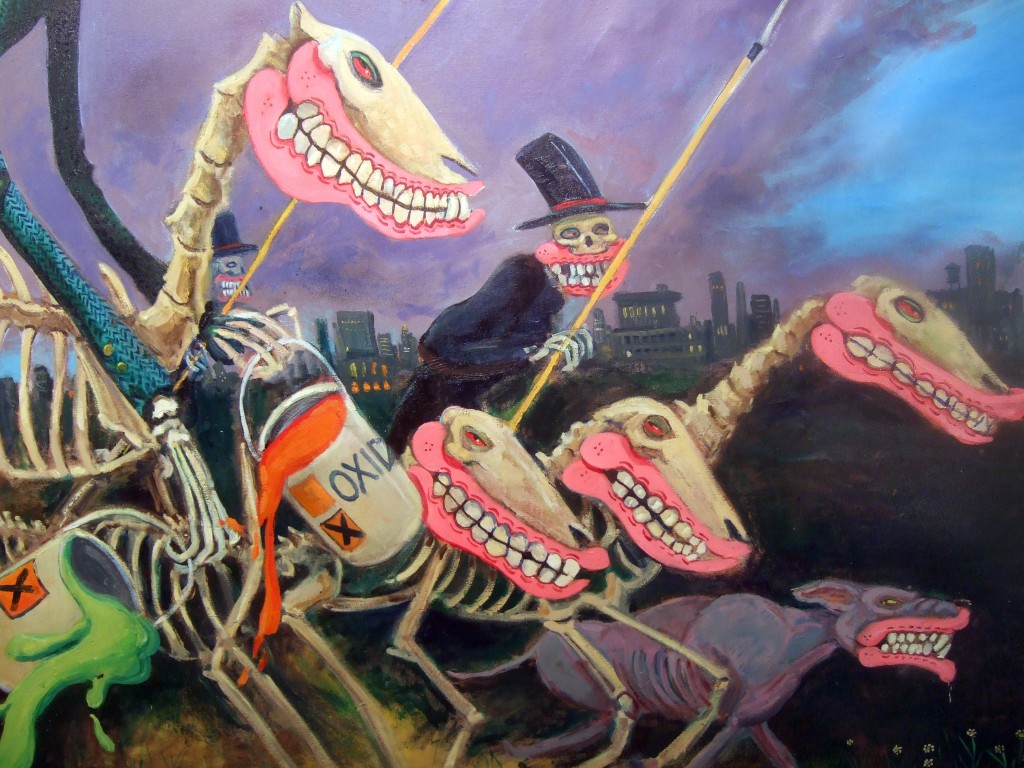
Prowling the streets of East London at night, with the premise that death should be a celebration, Sweet Toof may well be the modern equivalent of Jack the Ripper, or so it may seem. But unlike Jack, Sweet Toof is not out to kill (or so he says)! Like his predecessor, this infamous character may have a penchant for top hats and disguises but rather than a knife, comes equipped with a spray can and roller pole.
As with Jack, Sweet Toof certainly leaves his mark wherever he goes – his trademark pearly white teeth and bubble gums, an ode to death but with a nod of appreciation to classical painting with a distinct Mexican undertone. For Sweet Toof, his work is not a product of a twisted mind but of a creative genius.
This month sees Sweet Toof open his first solo show in New York City at Factory Fresh. Before he flew out to the Big Apple I disturbed his last minute preparations to ask him a few questions…
I have heard you have been planning for a show in New York called ‘Dark Horse’. Can you tell me a little about what it’s about?
The show is a series of oil paintings, with sort of a street influence. And the name Dark Horse comes from the saying – “You’re a bit of a dark horse.” I like the expression, being a dark horse, it’s sort of keeping things under wraps. And sometimes if you’re being a dark horse you might end up surprising yourself and others. You just get your head down and do something a bit different, maybe it’s a bit of the unexpected.
But then also the whole horse thing is about transportation and going out on a painting mission. If you imagine going off on a mission painting, it’s like how to get away really quickly. Plus I’m into the whole Mexican Day of the Dead thing and there are a lot of horseback riders within that – the horse of death transporting the dead. But it’s generally about going on a mission, creating a stampede.
I started researching horses, looking at Muybridge’s photos and the history of horses, how they were used in battles, and the Trojan horse of Troy. Those sorts of elements allowed me to get into it as a sort of subject matter that embedded into the work.
So horses feature heavily in the pieces?
There are a lot of characters on horseback but that’s not the prime thing. It’s more about the getaway. You know, the modern day horse is the bicycle, so when you go out painting you would have your bike and your roller pole. And then it’s quite menacing, police use horses to almost intimidate people. It’s to create an atmosphere. But I’ve also used the experiences of painting outdoors, doing missions and the things that happen. And then I looked at art history and old master paintings and it sort of goes from there really.
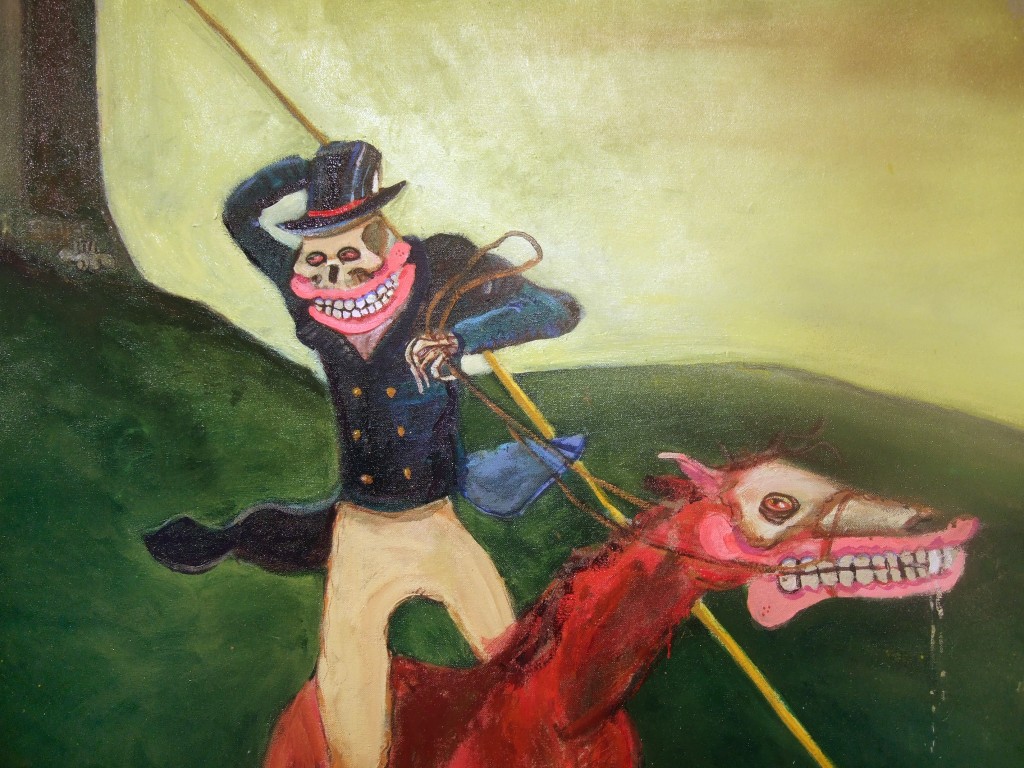
Has New York as a city impacted upon the work at all?
It’s the skyline, the nitty-gritty nature, the lighting and the atmosphere. I’ve been once before and I’m really into the rooftops, the architecture of the buildings and those traditional water towers. I remember going across Williamsburg Bridge with a friend in his little old meter maid’s car, I looked at the whole skyline and I just found it really inspiring seeing all the lights. It’s pretty mad. Within the paintings I’ve got some little cityscapes and some water towers appear. And then there’s the whole idea of leaning over and doing reaches and stuff.
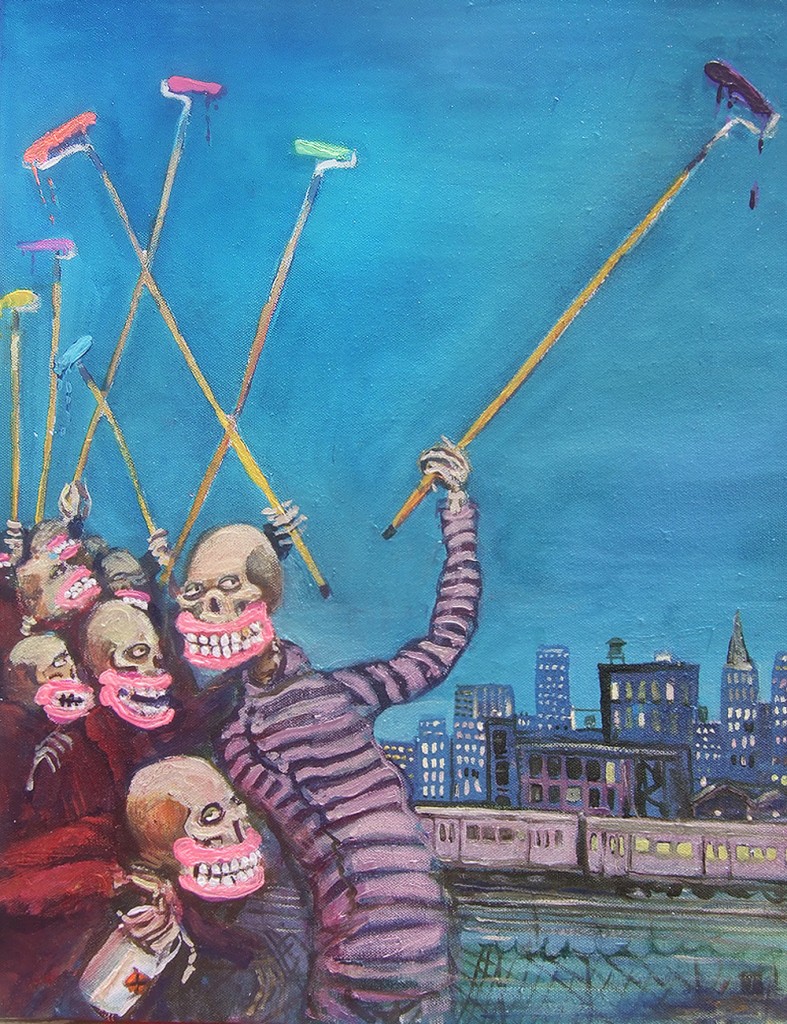
Obviously New York played a key role in the graffiti revolution but did the city and its early subway graffiti influence you too?
Massively. Subway Art and the classic documentaries; Beat Street, Wild Style, Style Wars. Most of the kids in England were really hit by that. But it was almost like once you had seen it you were cursed by it. Some of my friends managed to get away from it but I just became really addicted.
I love that whole thing of the subway trains moving through the city, just the noise of it and the atmosphere, the history of paint layers on top of paint layers, the buff, just everything. The aesthetics of it all seemed amazing. And then the mystery of all the names. We used to get up and write our names before becoming more character-based. Then I sort of came up with what I do now.
Would you note any of those early train writers in particular as highly influential for you and your friends?
I used to spend hours looking at Dondi’s whole cars in Subway Art. But also Seen, Lee, Mitch, Comet, Butch, and all the other people whose pieces you would see and be blown away by.
But really, it was just the things you got to see. Like a little cutting in a magazine, or maybe something on the telly. Back then we didn’t have the internet or any glossy magazines. It was little black and white photocopy stuff you had, or a battered up copy of Subway Art that would be tagged up and bombed.
But nowadays you can see anything at the click of a button, everything’s there. Maybe that’s helped the development of graffiti and styles, but I just loved the whole rawness when we started in the beginning, the freshness and all the break dancing and body popping, the whole energy of it all. And a lot of that energy came from New York. It wasn’t just through the art, but through all the dancing and Hip Hop music as that was obviously imported. I really fed on that energy and it came through in my painting.
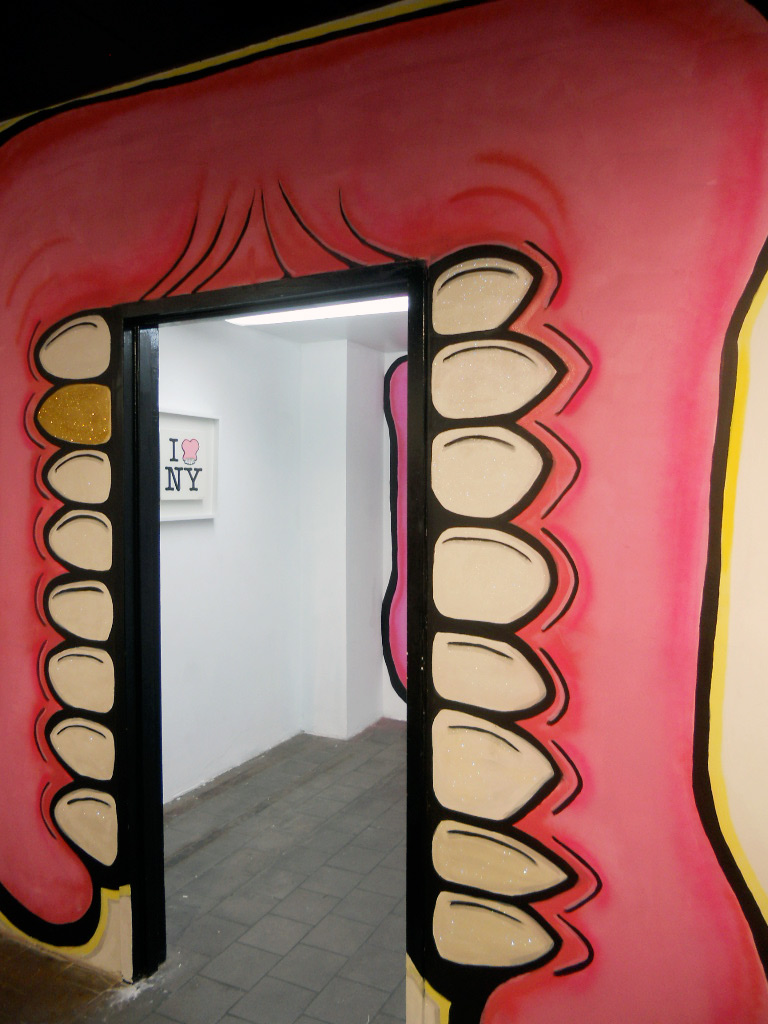
Within your work, death plays a prominent role. And as you have already mentioned you are influenced by the Mexican Day of the Dead. Can you explain why death is so important to you?
When I was about 18 or 19 I experienced a lot of death in my life. I was from a small town and within a year about 10 or 11 people died in different ways. That sort of freaked me out but it was also sort of my first introduction to death.
It was friends drowning in fishing boats, car crashes, falling out of a window, burning alive in a fire, flying off a motorbike. It was a year of everyone dying who was the same age as me. It was just really freaky, especially when I looked at my school photographs and realised that half the people had gone. Death just became really familiar.
Plus I’m influenced by the Mexican Day of the Dead. They really celebrate it, and I think death should be celebrated, I wouldn’t want people to be all doom and gloom. The idea is quite fascinating as it’s all about the unknown.
That’s a pretty harrowing upbringing. No wonder you paint a lot of skeletons and teeth.
There is also the anatomy thing – that our skin is built over a framework underneath. All through art school one of the first things you look at is the structure of skeletons. I remember doing an essay on death and mortality in painting which led me onto Vanitas painting by all the Spanish masters, the symbology of the skull, and then different objects within painting, like daisies. You know, like the expression “pushing daisies.” Then little daisies started appearing in my paintings. It’s all generally about the symbology of objects, but I suppose that’s different to some of my street stuff.
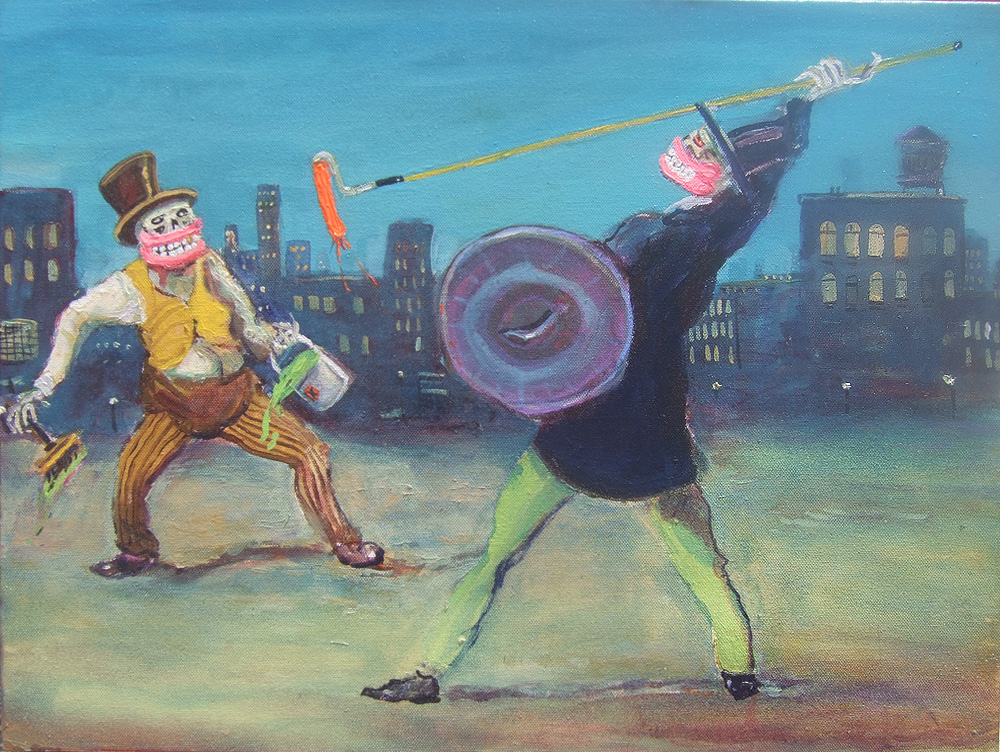
On the subject of the street, you have become infamous for your teeth, hence the name. Can you explain a little about the pearly whites and bubble gums?
When you die your teeth are left. Not that I have killed anyone, but when someone finds a body that they can’t identify they will use dental records. So it’s almost like a little clue, it’s a bit fascinating.
But the whole teeth thing came from when I did letterforms. I used to put teeth within my letters, like within S’s. It’s a bit like Seen where he used eyes in his pieces. That was sort of the beginning. Plus you get those little candy sweets and I thought I would start doing those. Its just 3 colours and it came from there really.
Everywhere you go you see teeth. There won’t be a day that goes by without you seeing someone’s teeth. Maybe they won’t have any, maybe they will just have one, and some may be pretty mashed up. They are sexy, they’re aggressive, they are all sorts of things.
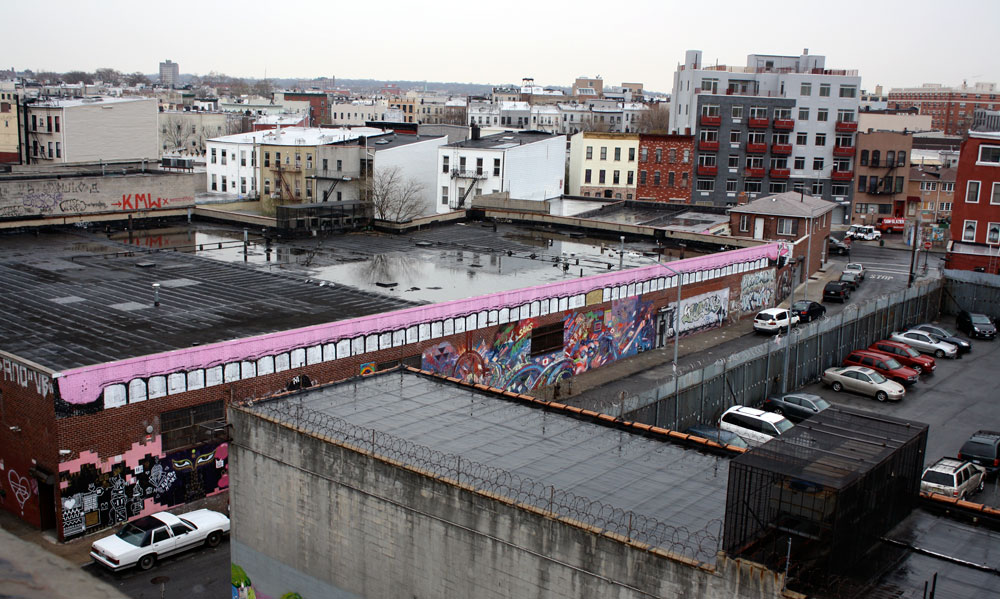
Do you think this content impacts on your style and your use of a range of mediums – linocuts, woodcuts, oil on canvas, screenprints and sculptural work?
I just think it’s like anything really. I love painting on the streets and I love doing a canvas. A canvas is just a portable surface, it’s light and you can carry it around with you. From painting, the obvious step is printmaking, like etching where you can get high contrasts. And when you look at different artists, you know, like Picasso, they always worked in painting, printmaking and sculptural work.
But ideas bounce between each different method. Sometimes I may do a painting and from that painting I will make a print, and from that print I may bounce back into a different painting. Or I may find myself doing some printmaking where I end up rubbing the ink away with a rag and that then may translate into an oil painting where I start rubbing around the paint. It’s like a visual language. When you do these different processes and different approaches to making stuff you create this language of image making and composition. So its feeds into each other, it all interlinks.
We have talked about your work indoors, but how do you approach painting on the street?
I quite like going out and not knowing things and just being spontaneous, and a lot of my work is done on the spot. Although I’ve done some walls recently with a friend, we planned things out a bit more and that’s nice. You sort of just look at the wall and see the maximum you can get out of it.
When I plan a wall, sometimes I will take photos and go away with an idea. But that idea may change to something else, so it’s always a little unpredictable. And even after it’s done you may think “Fuck I could have done this or done that in a different way.”
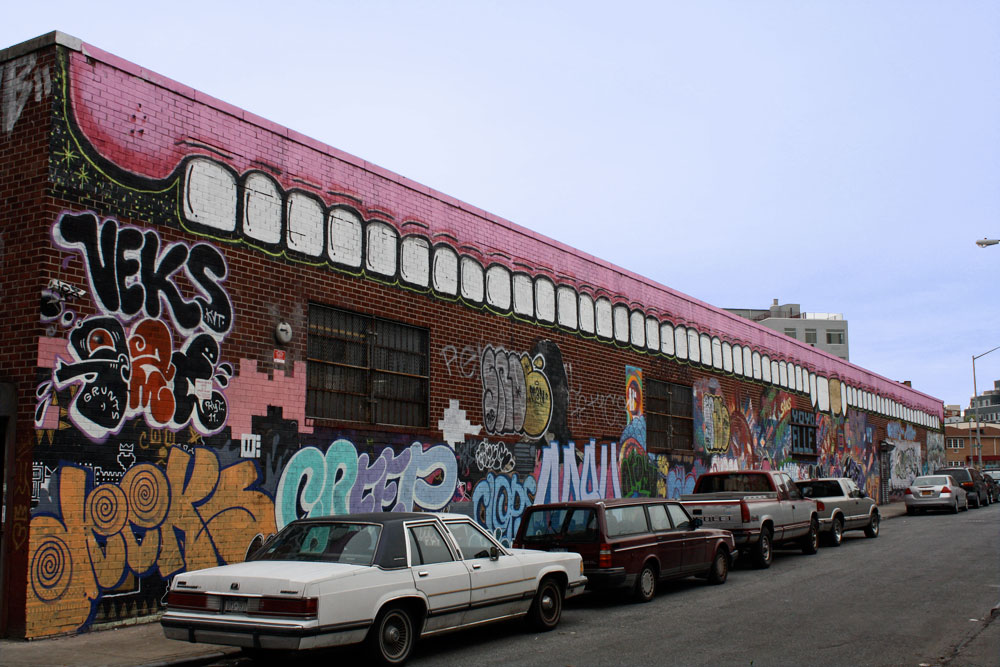
I heard that you left Burning Candy last year, but you mentioned that recently you have been working a bit with a friend. Do you prefer to work alone or in collaboration with someone else?
Yeah, I decided to leave last year, it just seemed right. And recently I have been working with [Paul] Insect, doing a few reaches. I like both – working on my own and going out with a friend. I used to love going out on my own and sometimes it’s safer I think, as you’re not looking out for someone else. But then again, sometimes it’s more risky as there is no one looking out for you. It depends, but obviously you just need someone that’s close and you can depend on and work well with. I like a bit of both really.
It’s been really great working in collaboration with people, but I think it’s equally as important to stand on your own two feet. I’ve been on loads of missions on my own and sometimes you just think “What are you doing?”, but I seem to feel more alert, I hear more, but may be a little bit more paranoid. And then funny things tend to happen to me when I’m on my own, like the time I thought someone threw a brick at me while I was doing a piece alongside a canal at night… it turned out to just be a big fish!
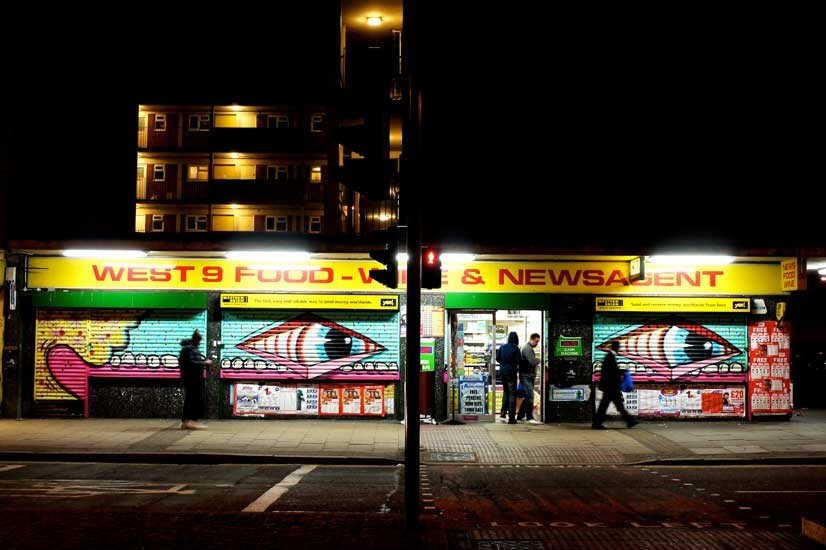
When you are out painting on the street you seem to use both a spray can and a roller pole, but which is your favourite?
I think maybe the roller pole, just because of the height you can get with it. And also, with a bucket of paint you have so much more coverage. It’s drawing on a large scale and it’s like trying to draw something with a mop. The control element is slightly different. With a spray can you can actually cut back and work into it, but with a roller pole I like the speed, and while it’s messier I think that’s probably why I like it. It feels more powerful in a way. Then again, with a spray can you can get fades and things you can’t get with a roller pole.
Do you ever feel the urge to go back to your roots and just go tagging for a night?
All the time. Although I do what I do, you see other stuff and you think “Oh I’d like to do that.” But I think you always return to your roots and you never forget your roots. I think that goes for style too and even the way styles progress, through the influence of New York and then the electro scene, old letterforms or maybe the stuff you saw on TV.
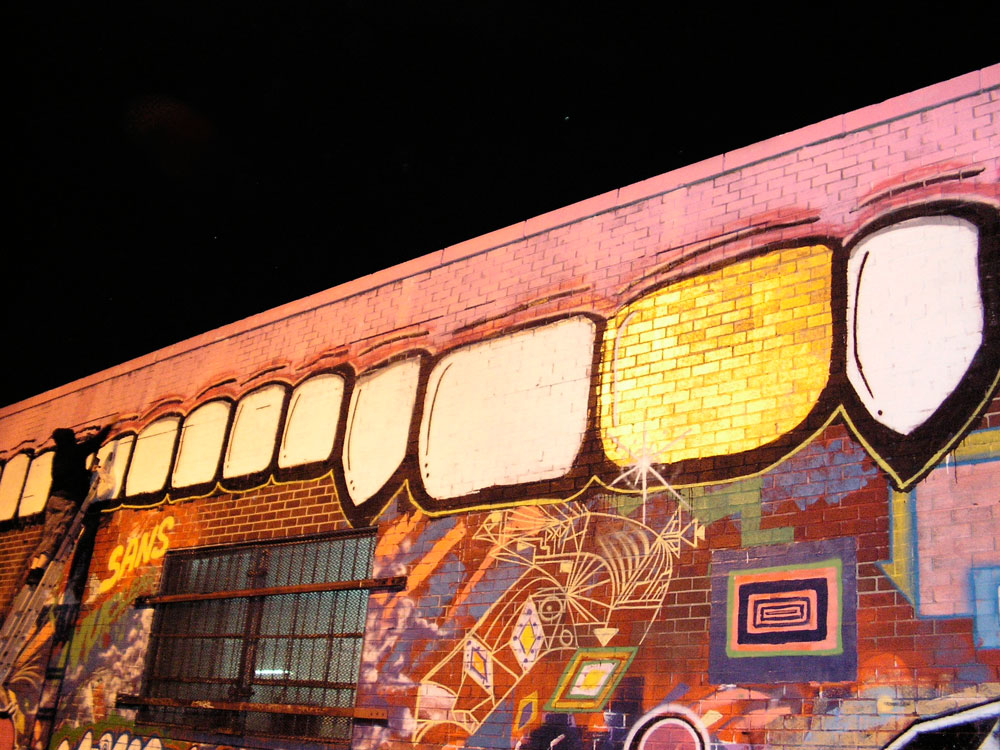
How do you feel your street work impacts on the city and public space? Is it about reclaiming space from the advertisers?
I’m not sure it’s really reclaiming space as I think that space can be anyone’s. You are forced to look at all sorts of advertising and that’s accepted. And if you have lots of money can put up whatever you want. Although if you go out there and do it off your own back, put stuff up, then it’s seen as vandalism, but that’s an argument people have had for years.
For me it’s more about making a head turn when people walk along. Making them ask, “Who’s done that and why have they done it?” Sometimes you don’t even know yourself and you go into a sort of trance but its nice to make people have a little chuckle, and some may start asking, “How have they done that, what were they thinking or what are they doing now?”
I suppose when I started I was a little more mindless and just put things anywhere, but then you get to the stage when you actually start looking at something. You think about the architecture, the space and the different parts of the space. I worked with Insect recently on a piece and brought animation into it. We started to think about how to use the space and how to max out the space, to do different things with the space.
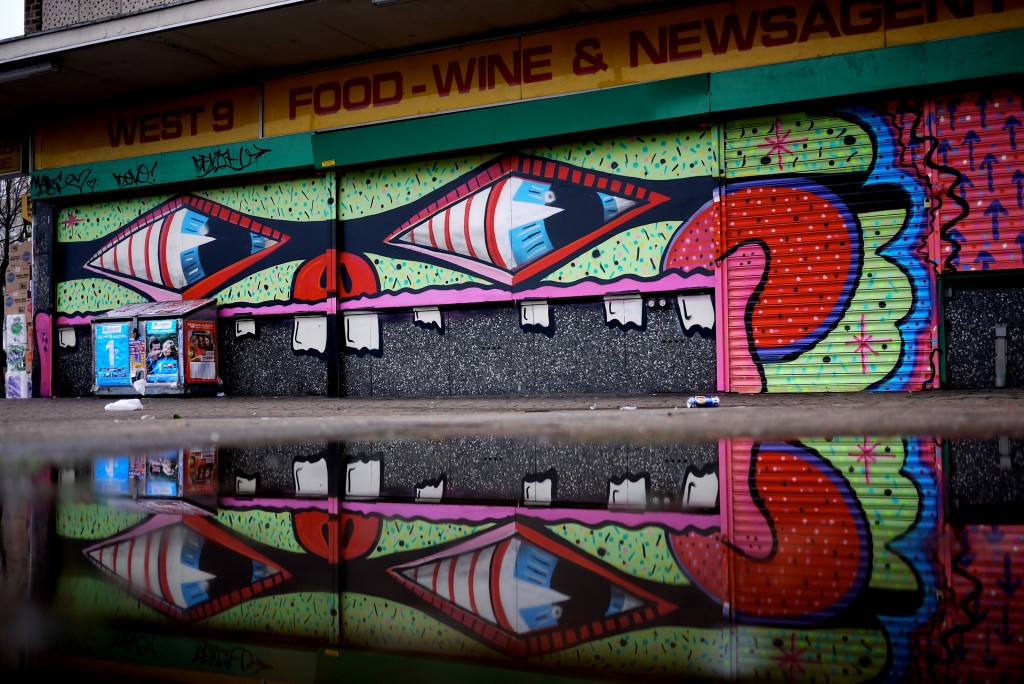
That’s refreshing to hear as often an artist will never consider the space where their work is displayed. But, what is the piece you are most proud of?
I’m not particularly proud of any piece. I tend to look at them all and cringe and think “What am I doing?” I suppose I like things you can’t believe you got away with. You cannot be too precious with it because its outdoors and people may go over it, you need to let go. I think that also keeps the drive going though. If it was the perfect piece, something “Wow”, I think my vibe would be gone and I would just think that I have done it all.
So you’re always striving to better yourself?
There is always that hope that the next piece will be better than the piece you have just done. You have to keep the drive going. There are times when you think “What was I doing?” but that just adds to the drive to improve and the need to keep putting pieces on the street.
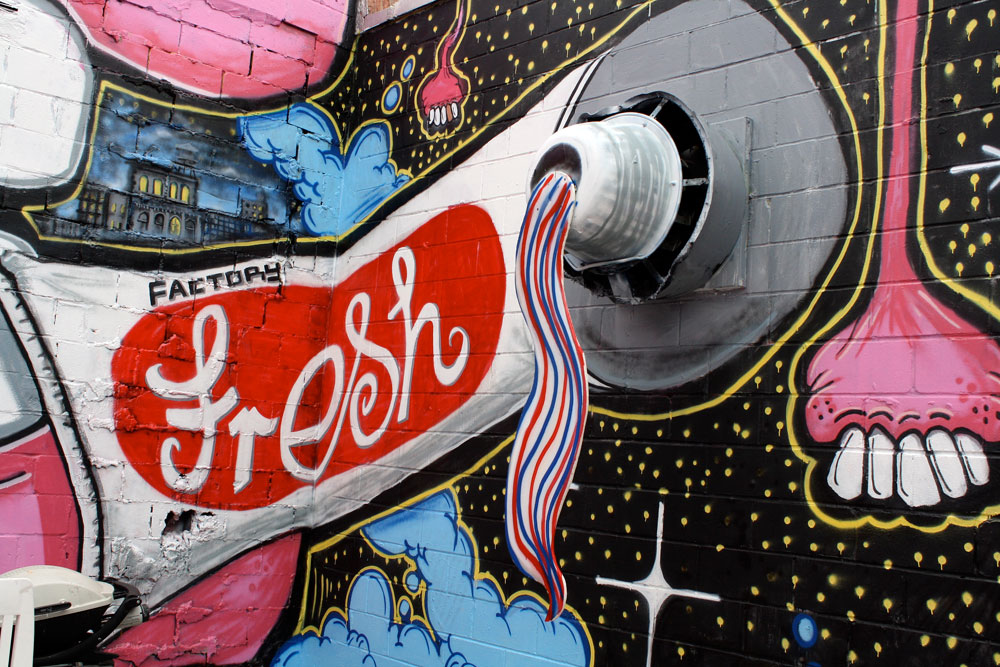
What do you think the future is for Sweet Toof?
To me painting is almost like a medicine – you have to keep it going outdoors in order to be able to work indoors. And as such I think what I have experienced from painting outdoors creeps into my paintings. I suppose I feel that I wouldn’t be able to make that work without going through the process of working on the street. Maybe there will be a time when I can retire, and just end up painting some watercolours and that will be it. But I think I will always end up doing cheeky little pieces outdoors.
So we can hope to see you collecting your pension holding a spray can when your 70 years old?
Ha ha yeah, going out tagging. It’s mad though, I’ve said it once before to someone that you become like a “Graffaholic”, you try and give up, and you try and do things the right way but there’s always that temptation. But there are times when the risks aren’t worth it when you have all this stuff going for you and you could lose it all. I suppose that does keep you on your toes.
Anyway, the future… perhaps I could just be really cheesy and say “I hope to take a big bite out of the Big Apple!” Ha ha, that’s the future!
Dark Horse opens at Factory Fresh on Friday, April 29th at 7pm and runs until May 22nd.
Photos by Sweet Toof and Paul Insect.
